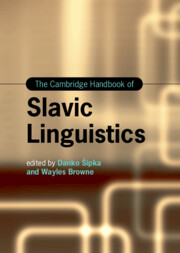Book contents
- The Cambridge Handbook of Slavic Linguistics
- Cambridge Handbooks in Language and Linguistics
- The Cambridge Handbook of Slavic Linguistics
- Copyright page
- Contents
- Figures
- Tables
- Contributors
- Introduction
- Part 1 Prosody and Phonology
- Part 2 Inflectional and Derivational Morphology
- Part 3 Syntax
- Part 4 Lexicon
- Part 5 Sociolinguistic and Geographical Approaches
- 26 Sociolinguistic Variation in Slavic Languages
- 27 False Cognates
- 28 Dialectal Fragmentation
- 29 Language Contacts
- 30 The Slavic Literary Micro-Languages
- 31 Heritage Language Forms
- 32 Scripts
- 33 Orthographies
- Part 6 Experimental and Quantitative Approaches
- Name Index
- Subject Index
- References
29 - Language Contacts
from Part 5 - Sociolinguistic and Geographical Approaches
Published online by Cambridge University Press: 16 May 2024
- The Cambridge Handbook of Slavic Linguistics
- Cambridge Handbooks in Language and Linguistics
- The Cambridge Handbook of Slavic Linguistics
- Copyright page
- Contents
- Figures
- Tables
- Contributors
- Introduction
- Part 1 Prosody and Phonology
- Part 2 Inflectional and Derivational Morphology
- Part 3 Syntax
- Part 4 Lexicon
- Part 5 Sociolinguistic and Geographical Approaches
- 26 Sociolinguistic Variation in Slavic Languages
- 27 False Cognates
- 28 Dialectal Fragmentation
- 29 Language Contacts
- 30 The Slavic Literary Micro-Languages
- 31 Heritage Language Forms
- 32 Scripts
- 33 Orthographies
- Part 6 Experimental and Quantitative Approaches
- Name Index
- Subject Index
- References
Summary
Throughout history, Slavic spread from a fairly restricted area somewhere around Ukraine, Belorussia, and Eastern Poland out to large parts of Europe, and Russian as the most widespread Slavic language today spans almost half of the Northern hemisphere. Historic and present migrations of Slavic speakers and the concomitant geographical expansion of their cultural and political dominions could not fail to afford rich opportunities for language contacts of all kinds, running the gamut from mild to intense forms of language contact, from lexical borrowing, language shift, and group bilingualism to the creation of new, contact-induced languages. Language contacts have been part of the history of Slavic from its very outset, and there is virtually no historical period for which no significant contacts can be identified. One of the tasks of this chapter is to give an idea of the deep historical layering of Slavic language contacts from Proto Slavic up to the present age.
Keywords
- Type
- Chapter
- Information
- The Cambridge Handbook of Slavic Linguistics , pp. 626 - 640Publisher: Cambridge University PressPrint publication year: 2024



